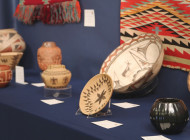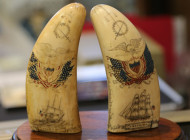By W.A. Demers
WASHINGTON, DC – Antiques dealers specializing in Asian art and US auction houses were among companies filing for exemption against Trump administration tariffs that were levied on Chinese art and antiques, including drawings, paintings, prints and sculpture, in August 2019. They were able to ultimately file for the exclusion from a duty levied on artwork and antiques that come from China during a three-month period beginning November 1, 2019. But now, as of September 1, those temporary exclusions, save the remaining exemption for paintings, have expired, leaving many in the trade facing a 7.5 percent tax upon entering the United States.
“It’s obviously very discouraging,” said James Lally, art dealer with J.J. Lally & Co. Oriental Art in New York City. “And regardless of the short-term extra expenses, it’s long-term effect may drive some people from the field into one where they don’t feel they are being unfairly treated.”
The major auction houses dodged this particular bullet for sales they planned during New York City’s weeklong Asia Week, which runs September 18-23 because potentially affected consignments were already in hand. “There are good auctions coming up,” said Lally, “because these are sales that were postponed from March, and they have had a long time to produce their catalogs.” But looking into 2021, he added, the prospects will not be as rosy.
“We were all extremely disappointed to hear that the exemptions expired with no clear path to reinstating them,” said Katherine Martin, chair of Asia Week New York. “When the exemptions were issued, it seemed like a light at the end of the tunnel, but it was so short-lived, and here we are again, burdened with these draconian measures that will drive business away from our market and will only achieve the opposite effect of their supposed intended purpose of undermining the Chinese economy. That said, the dealer and auction house participants in Asia Week New York are doubling down our efforts to support the field. We pulled together a special viewing room Summer 2020 exhibition in July accompanied by an extremely popular Zoom webinar with three scholarly presentations from museum curators; and we’re following up with an Autumn 2020 exhibition with an expanded viewing room exhibition and a lightning round presentation by our participating dealers on Zoom.”
“Imposing tariffs on Chinese art is yet another blow to a US art market already crippled by COVID-19,” said Kate Fitz Gibbon, executive director of the Committee for Cultural Policy. Trade groups have been active in opposing the tariffs, which will disproportionately harm small businesses. Additional long-term harm will be to collectors, museums and to the public, which benefit both by the expertise and passion that collectors and specialist dealers bring to the Chinese art field, and through the art donations made by collectors to US museums. The 7.5 percent tariff on Chinese art will apply to imports from all countries, not just art coming directly from China. This will make the exact same object of Chinese art more expensive to buy in the United States than in other countries and make it difficult for US dealers to compete in the global art market. It will have zero negative impact on China, since antiques by definition can’t be manufactured anew – only fakes. The vast majority of antique and archaeological items from China have been circulating in international markets for hundreds of years.”
Fitz Gibbon added, “Instead of punishing China, imposing US tariffs strengthens China’s monopoly on the ancient and antique art trade of Chinese goods, of which it is the world’s largest consumer.”



